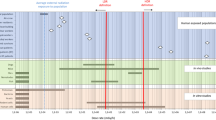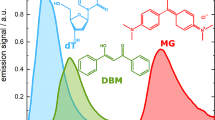Abstract
MOLECULAR asymmetry represents a striking characteristic of living organisms and their products. The precise mechanism(s) involved in the origin of this asymmetry in nature is not known, although Vester1 and Ulbricht2 proposed that it may have originated through preferential destruction of one enantiomer of a racemic mixture by spin-polarised electrons arising from β-decay, or circularly polarised bremsstrahlung produced during their deceleration. However, tests of this hypothesis have yielded results which were either negative or, at best, of borderline significance3. Recently, however, Bonner et al.4,5 reported the asymmetric degradation of the amino acid DL-leucine on irradiation with a beam of longitudinally polarised 120-keV electrons (degree of polarisation 10–27%). Electrons polarised with their spins antiparallel (AP) to their momenta were reported to cause preferential destruction of the D-enantiomer. Moreover, the L-enantiomer of leucine was reported to be preferentially destroyed by electrons polarised with their spins parallel (P) to their momenta. These results were of special interest as electrons emitted in β-decay have AP spins and also it is the L-isomer of leucine which occurs in nature. The precise physical processes responsible for such an asymmetric degradation remain unclear. We report here that using an electron source6 which provides a much higher degree of polarisation (typically 43%), we have reinvestigated the effect of irradiation of DL-leucine with longitudinally polarised electrons. In particular, the increased spin polarisation was expected to result in a more pronounced asymmetric degradation. However, no asymmetric decomposition was observed.
Similar content being viewed by others
References
Vester, F. seminar, Yale Univ. 7 Feb. (1957).
Ulbricht, T. L. V. Q. Rev. 13, 48–60 (1959).
Ulbricht, T. L. V. Nature 258, 383–384 (1975).
Bonner, W. A., Van Dort, M. A. & Yearian, M. R. Nature 258, 419–421 (1975).
Bonner, W. A., Van Dort, M. A., Yearian, M. R., Zeman, H. D. & Li, G. C. Israel J. Chem. 15, 89–95 (1977).
Hodge, L. A., Dunning, F. B. & Walters, G. K. Rev. Sci. Instrum. 50, 1 (1979).
Kehiher, P. J., Dunning, F. B., O'Neill, M. R., Rundel, R. D. & Walters, G. K. Phys. Rev. A 11, 1271–1278 (1975).
Kessler, J. in Polarized Electrons (Springer, Berlin, 1976).
Boersch, H., Geiger, J. & Stickel, W. Z. Phys. 180, 415–424 (1964).
Bonner, W. A. J. chromat. Sci. 11, 101–102 (1973).
Bonner, W. A., Van Dort, M. & Flores, J. J. Analyt. Chem. 46, 2104–2107 (1974).
Author information
Authors and Affiliations
Rights and permissions
About this article
Cite this article
HODGE, L., DUNNING, F., WALTERS, G. et al. Degradation of DL-leucine with longitudinally polarised electrons. Nature 280, 250–252 (1979). https://doi.org/10.1038/280250a0
Received:
Accepted:
Published:
Issue Date:
DOI: https://doi.org/10.1038/280250a0
- Springer Nature Limited
This article is cited by
-
Force of nature gave life its asymmetry
Nature (2014)
-
An inquiry into the selective protection of glycine during the radiolysis of glycine-alanine mixtures in aqueous solutions and its implications to the preservation of optically active amino acids in the early earth
Journal of Biological Physics (1996)
-
The origin and amplification of biomolecular chirality
Origins of life and evolution of the biosphere (1991)
-
Beta-gamma decay and stereoselective molecular breaking
Journal of Molecular Evolution (1987)
-
Investigation on the asymmetrical induced yields in90Sr-90Y-beta-irradiated D- and L-alanines
Origins of life and evolution of the biosphere (1986)





